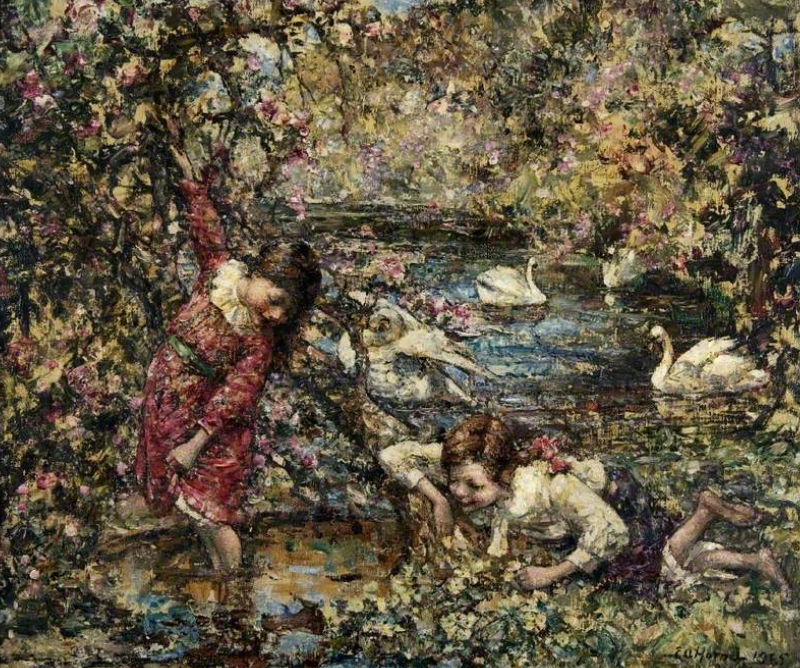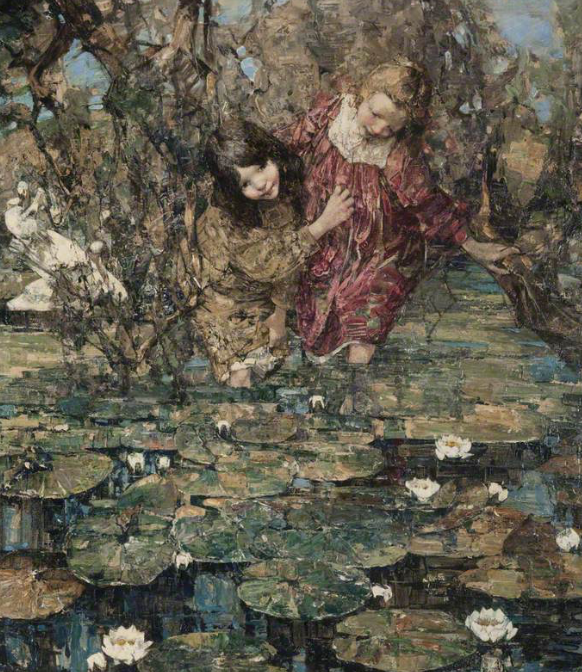Nesting Swans, Lily Ponds, and Seashore Roses: The Tender Spirit of Scottish Springtime
By Isabelle Holloway
Sometime in the month of March, by the mist hanging over a rayless sea, a pale, youthful light eases itself into the shaded crevices of Scotland’s wintry gloom. Crags and moors, glens and straths, all perfectly Scottish, are interrupted in their low-lying shade and long, sunless sleep. Ospreys and damselflies, daffodils and snowdrops, mulberries and rhubarbs, all things that rouse visions of life and abundance in the most colorful sense seemingly erupt in one grand, gilded arc above now-teeming treetops and lush forest floors. Such is the wild joy conveyed by the work of Edward Atkinson Hornel.
Bessie MacNicol, Edward Atkinson Hornel, 1896, oil on canvas, 74 x 63.5 cm, National Trust for Scotland, Broughton House & Garden.
Despite being born in Australia, Hornel’s career and upbringing has woven him into the fabric of a richly Scottish tapestry. His childhood roots him into the same soil of his parents - Kirkcudbright, a town in which he later reestablished for himself a studio after completing his studies in Edinburgh and Antwerp. During his time in the studio, he became associated with the “Glasgow Boys” and developed a strong, working relationship with George Henry, with whom he established great success in experimental representations of the Eastern vogue. Hornel’s own style ultimately matured into characteristically idyllic scenes, adorned by young girls and blooming with flora and fauna. It is between the budding life and shrubbery of such gardens that the image of spring, clear and true, reverberates soundly as a ray of light. It serves itself as a delicate harbinger of hope and of new beginnings for all cast within such frames, and equally so for all standing before them. In particular, Hornel’s gardens cultivate a thematic, even euphonious, trinity of nesting swans, lily ponds, and seashore roses.
A strangely murky “daydream” of a pool’s surface swoons kinetically with the lingering breaths and sweeping motions of Spring in Girl with Nesting Swans and Two Girls and Swans at a Pool. In a hazy way that is altogether ambiguous and indistinct, one notices the fusion between boughs and leaves, and between blossoms and swans. The sky is largely concealed, emerging only as echoed glints upon the stippled, pool surface. Unassuming, unrushed, and with a sensation of tender force, not unlike as if the viewer were to, at once, behold the swans just before themselves, the swans drift silently across the frames. A Girl with Nesting Swans hearkens to Spring’s new origins through by the romantic gesture of requited bowing between the swans - a gesture which contains all the sweetness of young love and all the maturity of an enduring relationship. Nearby, a girl lays still, fully enveloped and embraced by the flowering brush. Clasping her hands above her knees and gazing wistfully at some far-off, atemporal view, the girl joins the viewer in partaking in the this verdant scene. In a similar spirit, Two Girls and Swans at a Pool reveals a dignified interplay of swans in complete ethereality - however, with the play of two girls before a more brilliant scene. By the cover of a draping canopy, the swans glory in solitude, still sharing in the experience of a haloed body of light. On the left, a girl clings to a hanging branch, grasping the hem of her smock with her free hand; on the right, another girl sprawls out easily upon the grassy floor. Both seem to epitomise the innocence and curiosity of youth and are intently fixed on some unknown, wading specimen in the water below - a full-bodied fish or toad, perhaps. The mirthful countenances of the girls and the delicacy of the swans coalesce into an image of pure, beautiful, and refreshing young Spring.
Edward Atkinson Hornel, Girl with Nesting Swans, 1897–1933, oil on canvas, 101.5 x 127 cm, National Trust for Scotland, Broughton House & Garden.
Edward Atkinson Hornel, Two Girls and Swans at a Pool, 1925, oil on canvas, 101.5 x 127 cm, Glasgow Museums Resource Centre (GMRC).
A wholly tender warmth emerges from the dynamics of the young girls and the water-lillied pond through which they wade. The sprawling trees and branches of the background bow down playfully, seemingly tickling the girls and water-lilies they shade. In an extension of their embrace, the two girls in Lily Pond appear to lean against one another for support, dipping beneath the gaps of swaying greenery, and gently fording the mossy pool. The tilting of their heads away from one another introduces a symmetrically fulfilling vision of balance - one that is not rigidly imposed, rather evoking the weighted proportions of contrapposto. In The Lily Pond, maternal sentimentality and pensive glee shines over the rose-tinted cheeks of the three girls. The chestnut-haired girl in central focus peers warmly off to the left, cradling the shoulders of a smaller girl. This younger girl bears an endearingly soft smile. Leaning into this pair with a cheerfully slyish face from the left, another girl, in a blue smock, arches her body and raises her arm loosely behind her, poising her leg in front of her. In both Lily Pond and The Lily Pond, the delicate scattering of the waterlilies across the canvas body complements the relaxed and sincere emotions shared by the young girls as they tread lightly.
Edward Atkinson Hornel, Lily Pond, 1905, oil on canvas, 114.3 x 99.2 cm, The Dick Institute.
Edward Atkinson Hornel, The Lily Pond, 1912, oil on canvas, 76.2 x 35.6 cm, Glasgow Museums Resource Centre (GMRC).
Glitterin waves which ebb and flow, together with sand-swept breezes, come to mind when regarding the 1906 and 1907 renditions of Seashore Roses. The adoring gazes of the girls in each scene are comparable, their heads bent toward one another in wholesome affinity, the only difference being the addition of a third figure in the latter. A restful tranquility parallels the lithe motions of the girls: their postures are thoroughly uninhibited, as they fully sprawl themselves out onto the grassy earth in loose-fitting, breeze-enveloping garments. Their eyes, too, are patient and attentive to beholding the small, hand-held splendor that is the monarch butterfly. A myriad of white and pink roses add rhythm to the butterfly’s quiet vibrance, flourishing hither and thither atop the greening cliff sides - an embodiment of nimble freedom, such that is epitomized by the young girls. Perfectly blue skies, wonderfully calm seas, and horribly beautiful rose blooms, all conclude and epitomize Hornel’s Scottish springtime vision - a vision painted in the wake of the simple rose’s late-spring peak, heralding in the sweet, honeyed days of Summer’s arising, golden hours.
Edward Atkinson Hornel, Seashore Roses, 1906, oil on canvas, 102.5 x 117 cm, Kirkcaldy Galleries.
Edward Atkinson Hornel, Seashore Roses, 1907, oil on canvas, 122.8 x 154.3 cm, City Art Centre.
The springtime motifs that seem to extend beyond the marked edges of Hornel’s halcyon works transport the viewer into a dreamy, youthful, radiant garden: a place where the swan’s downy plume or the rose’s light perfume excite sensory experiences so tangible that one could almost retain the memory of the photo-bleached impression such teeming scenes provide. By embodying the viewer with a child’s zestful spirit, and by employing a classically feminine touch which nurtures and tends, Hornel brings, with a brush, the Scottish soul of spring to life.
Bibliography
“Artworks.” Art UK | Discover Artworks, https://artuk.org/discover/artworks/search/actor:hornel-edward-atkinson-18641933/page/3.
“Edward Atkinson Hornel - Kirkcudbright Galleries: Dumfries and Galloway: Artists: Gallery.” Kirkcudbright Galleries, 30 Mar. 2020, https://www.kirkcudbrightgalleries.org.uk/artists-footsteps/artist/edward-atkinson-hornel/.
“Edward Atkinson Hornel Paintings for Sale.” Leighton Fine Art, 18 May 2020, https://www.leightonfineart.co.uk/artist/edward-atkinson-hornel/.







